
CAFS - Straight answers for the beginner or the expericienced user.
By: Neal Brooks (As Published in Fire Apparatus Magazine - A Four Part Article - January, February, March, & April 2005)

Only if you are new to the fire service or have had your head buried in a bucket of sand, are you unaware of one of the more heralded advancements in fire suppression development, the compressed air foam system (CAFS). For some, CAFS might appear to be a radically new development in the fire service. In fact, CAFS has been in use in the United States for over three decades. I have had a wonderful opportunity over the past five years to travel the country extensively, doing hundreds of CAFS demonstrations, live burns and other presentations. I am happy to report that there is an increased awareness of the existence and use of CAFS in structural suppression and other fireground operations. However, there still exists a lot of confusion and, in some cases, misconception as to what CAFS is and what it is capable of doing.
Defining CAFS is easy as an acronym, but what exactly is "CAFS" and what makes it so different from traditional methods of fire suppression?
I am going to address many of these issues starting with the assumption that the reader has limited or no knowledge of CAFS. CAFS is not a new-fangled, magic pill, conjured up by some mad scientist/firefighter working in the basement laboratory. Rather it is an improvement in the way we have been approaching fire suppression on the planet Earth for years. I imagine man discovered the extinguishing of fire sometime around the same era he discovered fire itself. Perhaps accidentally or in the event of an untimely rainstorm, his valiant efforts of rubbing sticks together, or wandering upon a recent lightning-struck tree were doused before his very eyes. And, folks, over the millenniums, we have not progressed a whole bunch from that point. Sure, we have better delivery systems and more reliable sources of water supply - hopefully. But alas, it is the same old water we have used for centuries as the preferred extinguishing agent of fire.
In order to understand a "modern day CAFS system" we need to look at the sum of the parts. The CAFS system in theory and principal is comprised of the following critical elements.
First and foremost is water - water carried on the truck in a booster tank, water from a hydrant or folding canvas tanks, or water from a stream, lake, pond, swimming pool, or some similar source.
Second, is foam. For the purposes of this article, we will
concentrate on Class A foam concentrate. A foam metering device, or
proportioner, is needed to accurately inject foam concentrate into the fire
stream. The foam concentrate/water solution may be pre-mixed in the tank, with
pros and cons to be discussed.

The third ingredient for CAFS is air. Air can be introduced from a compressor which is a mechanical method of introducing high volume air into the fire stream by using a vane-type, or rotary-screw industrial air compressor. Larger CAFS today use some type of on-board compressor.

Smaller portable units may also be pneumatic (non-mechanical) in design in which a vessel is pre-charged with air. This may be an independent air supply or may be used in the same vessel in which a pre-mixed foam/water solution exists. These units can be as small as a backpack unit and as large as one requiring a motor vehicle to transport its contents.
HERE IS A TYPICAL CAFS SYSTEM ATTACHED TO A FIRE PUMP
(Darley LDMBC)
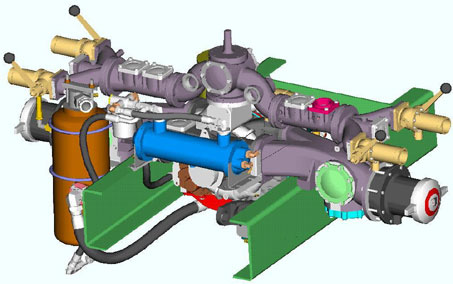
Those are the three essential elements for a functional CAF system - water, foam and air.
Now, let's take a look at what happens if we use any of these elements solo or in tandem. First, let's consider air. If you've ever attended a birthday party with a cake supporting a moderate fire load of candles, you know that with sufficient volume and force you can "blow them out." In this basic example what we achieved by blowing across the flames of the candle was the rapid removal of the heat from its fuel source. While this method is obviously limited in its practical fireground application, it does exist. Many forestry units use portable air-driven backpack units, similar to leaf blowers, to propel the flames away from the fuel source. In structural fire fighting this could lead to disastrous results so, obviously, it is not used in suppression efforts.
Next, take a look at foam. In the traditional sense, when the word foam is used in the fire service it conjures up visualizations of flaming gasoline-laden tankers on their side, spewing massive black clouds of smoke and intense flames. When faced with flaming tankers billowing black smoke, the only answer, you say, is to it hit with foam. In that respect you are correct, but as we review the various foam types, this is a scenario for the traditional foam we know as aqueous film forming foams (AFFF), and alcohol-resistant aqueous film forming foams (AR-AFFF). While there are suppression systems using "pure foam concentrate," they are generally relegated to industrial uses, such as a purging system to flood the contents of a tank or similar vessel. We more commonly see foam used in portable fire extinguishers and that is more often than not a foam solution, not a straight foam concentrate. The various notations on the extinguisher itself determine the intended use, such as Class A fires, Class A,B,C combinations, etc. Again, foam can be used in structural applications (Class A) as well. However, it is most commonly used as an additive and an enhancement to the water supply.
Now, moving on to water, it might be good to ask why we use water in the first place. What are the positives that water brings to the fireground? In most cases, water is the preferred method of extinguishing fires. While water has many positive effects in extinguishing efforts, there are negatives as well. Consider, for a moment, that civilization needs water to survive. Since there is a supply available to sustain life, this means there should be a viable supply for fire suppression as well. It is there, often most readily available, and the least expensive extinguishing agent. However, let's take a look at the poor inhabitant of the desert tending his flock with his limited water supply cautiously guarded in his goat flask. If his tent were to catch on fire do you think he would be using his last precious drops of water to put it out? In all probability, he would be kicking sand, and plenty of it because it is readily available, and it will get the job done. So, my point is just that - we use what is most readily available, effective and economically prudent. Something to keep in mind about water is that it has a high heat transfer value. That is optimized when used on fire through vaporization and conversion to steam. In essence, water and its cooling effect aids in removing the heat of combustion. Water is also easily transported and applied from long distances with modern-day fire apparatus. From the days of bucket brigades, to horse-drawn steam engines, the fire suppression service has seen vast improvements in apparatus, hose and application appliances.
So, I believe it is easy to see why water is the choice of the fire service for suppression purposes. But, keeping that in mind, there are also some limiting factors, and perhaps even dangers, in using water. Here are some things to keep in mind when a decision is made to use only water as an extinguishing agent.
Water lacks the ability to penetrate and has a propensity to run off of vertical surfaces due to the surface tension of the water molecule. Surface tension in the fire service is a double-edged sword. If it were not for surface tension and the bonding together of the water molecules, our fire stream would hold no recognizable form as it exits the end of our hose. Without surface tension to keep the water molecules together, the water would simply disperse from our hoses in all directions and limit the distance, despite any efforts to propel it with modern pumps and nozzle devices. So in that sense surface tension is a necessary evil. On the other hand, it is surface tension that hinders the ability of water to penetrate or soak in, especially on carbon-based items.
This is one of the primary reasons we add detergent foams (which just happens to define the chemical composition of a Class A foam) into our laundry. It is the foam or "soap" that breaks down the surface tension and allows our water to penetrate. This is not only important in getting our clothes clean, but decidedly more efficient in using water on the fireground for suppression. Have you ever noticed how a drop of plain water just puddles on a piece of charred wood and doesn't soak in? That's because of the water's surface tension.
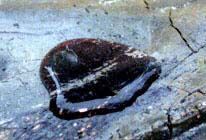
Another thing to think about when using plain water is sometime the amount of water available, or rate of delivery, is insufficient to overcome the heat generated by the fuel load.
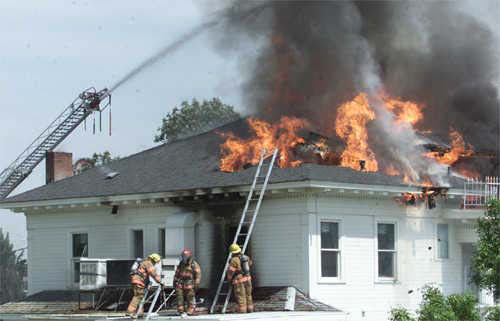
Gravity also causes a substantial decrease in the amount of water that effectively cools. And we shouldn't forget that water is a conductor of electricity and can react violently with certain metals, such as magnesium. In addition, untreated water might actually aid in the spread of hydrocarbon fires, such as gasoline, diesel fuels and similar liquids.
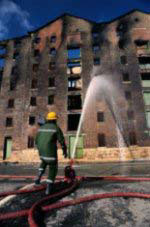
It's a fact that the larger the fire, the larger the hose line becomes to handle the additional volume of water being discharged. This equates into heavier handlines which require additional manpower and are often much more difficult to maneuver. This also requires larger fire pumps, additional fuel usage, and often leads to increased fatigue of men and equipment. You get the idea.
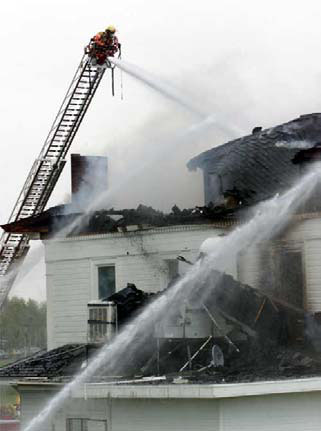
Where large volumes of water are required to effectively achieve knockdown, there is a potential danger of structural collapse due to the additional weight of the water. Remember, a flow rate of as little as 250 gpm, (blitz attack) adds one ton of additional weight per minute of application! This creates an additional hazard on the fireground and has led to many firefighter and civilian deaths and injuries. The National Fire Protection Association reports that 18 percent, or 56 firefighters of the total 316 firefighters killed at structure fires between 1989 and 1999, died because of structural collapse.
In areas where water is not readily accessible, we often rely on transporting water to the scene in tankers. This is a very time consuming and dangerous method of sustaining a continued attack. In addition, this practice injures and claims the lives of many firefighters, year in and year out. According to the "Firefighter Fatality Retrospective Study," published in October 2001 by the National Fire Data Center, motor vehicle collisions account for between 20 and 25 percent of all firefighter fatalities annually. According to that same data, more firefighters are killed in tankers (19.5 percent) than engines (13.8 percent) and ladders (3.2 percent) combined.
Even though water is the best agent we have, there are undeniable truths as to its limitations and dangers in using water on the fireground.
There are undoubtedly veterans out there who are sure to echo "we've been doing it that way for years and it still works." Consider this, "you can kill a polar bear with a stick, too, but it just might not be the best method."
Now let's move back to foam for a minute. In order to understand the importance of foam in the CAFS application, we need to examine the types of foam concentrates normally found on the fireground. We also need to go back to the basics and understand the various fuel classifications and look at what foams can be used on the different fuels.
Class A fuels are wood, plastics and rubber - three dimensional fires. Class B fuels are flammable liquids and gases and Class C are energized electrical fires while Class D are flammable metals.
Class A foams can be used in structural fire extinguishing and overhaul, exposure protection and wildland fires.
Class B foams are well suited for hydrocarbons and polar solvents, vapor suppression and extinguishing. And, lastly, we have emulsifiers and spill response agents which are good for vapor suppression and hydrocarbon recovery.
There are also several foam concentrates, including synthetic detergents in Class A foam and high-expansion foam.
Class B foam concentrates include protein and film forming fluoroproteins (FFFP), aqueous film forming foams (AFFF), and alcohol-resistant aqueous film forming foams (AR-AFFF).
For the purposes of this article we are going to focus on Class A foam usage. Class B foam or more commonly AFFF, can be used in a CAFS system as well, but it is not commonly used in this manner and should not be used for structural applications.
Here are some things we should know about Class A Foams:
Class A foams are good at wetting and cooling fuels, suppressing flammable vapors and reducing smoke. Class A foam also has an opaque surface to reflect heat, creates insulating bubbles, holds water on any surface, is biodegradable and has low mix ratios 0.1 percent to 1 percent.
For all of its qualities, Class A foam has some limitations related to the users' confusion with Class B and knowledge base, and in overcoming tradition.
Now, let's review some foam properties, terms and performance issues:
Surface tension indicates water's ability to penetrate and spread regardless of drain time or expansion.
Expansion ratios, volume of foam/volume of foam solution, are as follows: low 1:1 – 20:1; medium 20:1–200:1; and high 200:1+
Quarter life drain time is the amount of time for foam to release 25 percent of its water, which is an indication of foam's durability. And lastly, we need to remember there are different types of foam, foam solutions, wet foam, fluid foam or dry foam.
Now that we've looked at the first two elements of the CAFS, water and foam, let's take a look at the air supply.
For the purposes of this discussion we will focus on pumping apparatus utilizing a rotary-screw compressor. The compressor should be high quality and suited for industrial-type applications. It should be capable of sustaining consistent, high-volume output of air (measured in Cubic Feet per Minute or CFM). The compressor might either be hydraulically-driven, belt-driven, or mated to the water pump or gear box.
In order to make it a positive addition to the pumping apparatus, it is imperative that the compressor not add any significant weight, additional compartment space requirements, or complicated operation.
The essential duty of the compressor is to aid in the formation of bubbles in the hoseline (referred to as scrubbing), and increase the distance at which the foam solution can be propelled from the point of discharge.
The more discharge points to be applied on the fireground means an increase in the output capacity of the compressor. This is one of the reasons a CAFS system has increased costs, as a compact, reduced weight, industrial compressor is very expensive to manufacture.
Part II
The invention of the compressed air foam system is one of the most heralded advancements in fire suppression in recent history. In the last column, we looked at water, foam and air, the three elements of CAFS and now it's time to look at how this new technology works together for fire fighting.
I know what you're thinking. You've heard that line, "new technology for fighting fires." There's always something "new and revolutionary" that will change the manner of fire fighting. Remember when they said high-pressure fog would do the same thing? Well, over the last five years of traveling from coast to coast, and in far and distant foreign lands, I have fielded questions like this a number of times. True, there have been a number of innovations that have come and gone, in many instances for good reasons.
Let's look at high-pressure fog as an example. In theory, high-pressure fog should work. Right? After all, we are breaking up a solid droplet of water into millions of tiny water droplets. This exposes more surface area, which in turn should result in an increased cooling effect. Right? Well it did, sort of. The shortfall of the system, first and foremost, was the ineffective stream reach. In essence, we had to be awful dang close to get the maximum effect. I can't fathom a guess as to how many firefighters and/or victims we unnecessarily "lobstered" before we figured this one out. Besides, it was still water that was subject to the effects of gravity and much of its limited stream never got a chance to reach the seat of the fire.
Consider for a moment the possibilities if there were a system that could overcome some of the limitations of water - a system or method of suppression that has withstood the test of time. What would you say to a system that can mechanically and chemically enhance water, thereby utilizing and realizing the maximum efficiency potential of our best extinguishing agent? Well, let me tell you, there is such a device and it is done by the addition of CAFS to a pumping apparatus.
CAFS is not new or a "flash in the pan." CAFS has actually been around for nearly 60 years in some shape or form. The British Navy used a similar system in the holds of its warships during World War II. Systems such as Halon did not exist at that time and the thought was to provide maximum suppression, limit fire spread, and achieve that goal in a cost effective and efficient manner, without excessive water usage.
Closer to home we can distinctly see the primal use of modern-day CAFS in the early "Texas Blizzard" or WEPS system. This was a basic CAFS system utilized in the 1970s by the Texas Division of Forestry. It was somewhat difficult to balance the three elements then as compared to today's system. However, I believe one of the more prevalent problems of that early developmental era was not so much the system as it was the foam available. There were few, if any, true Class A foams available to the fire service back then. The emphasis was more on protein foams and foams for hydrocarbon fires (AFFF). Therefore, one of the foams used by the forestry service was an actual byproduct of the forestry industry, pine oil "soap." While I am sure it worked in a positive manner, it did not have all the abilities of modern Class A foam. In addition I suspect it might have even contained a slight flammability potential as well.
It is important to note some of what I have pointed out as being negatives in the early progression of CAFS, had limiting effects on its popularity. As our foam manufacturers saw the market potential increase and their focus started shifting to the production of a "true" Class A foam, a necessary and vital component of a successful CAFS system.
Complaints regarding the difficulty and inconsistency in fireground operations of the early CAFS prototypes led to pump and apparatus manufacturers looking for new ways to overcome the problems. One way to overcome the obstacles was the idea of batch mixing foam in the booster tank. That would have been a fine idea if certain conditions existed. For one, the solution in the tank would have to be Class A and Class A only. If some well-intended firefighter inadvertently mixed a Class B foam in the booster tank, it would end up being a congealed mess.
Secondly, the full contents of the booster tank would have to be used within a reasonably short time. Because foam concentrates have the ability to readily mix with water (hydrophilic action), it also begins to break down or deteriorate rapidly. As a matter of fact, foam loses the majority of its effectiveness after 30 days while in suspension in water. But that's also good news because that's why Class A foam is environmentally friendly, it's made to be biodegradable. To batch mix in the booster tank, a separate gravity fed "foam cell" could be attached to the booster tank, but there was no way to prevent water and air under pressure from invading the contents of the foam cell and contaminating it as well.
Because of these above-mentioned shortfalls, manufacturers found it necessary to develop accurate foam "metering" systems. The systems would allow the foam to enter into the fire stream either by eduction (venturi action) or, to achieve a more precise method, an induction system. An induction system is a positive displacement pump that allows the precise metering of foam concentrates regardless of pump discharge pressure, flow rates, or engine RPM's. With the addition of check valves on all three components the potential for cross-contamination or back-up was eliminated.
Admittedly, CAFS was a very small segment of the market way back when and very few pump and apparatus manufacturers took the lead in developing a dedicated CAFS system. Even as we progressed into the ‘80s and ‘90s, in many instances the CAFS systems were no more than a standard fire pump with a hastily added foam system and an "air source."
The air source might have been a simple pneumatic system relying on the stored air supply in a portable or on-board vessel. These were extremely limited in application and use, and were most often relegated to brush-type units. The larger pumping apparatus employed some type of on-board compressor. The manner of driving the compressor also could compromise the system. If it was belt driven off of the engine it may not receive the necessary RPM's to achieve the proper air volume output. Initially, there were not a lot of compressors designed specifically for the fire market. Because of this it was necessary to adapt an industrial-type compressor, which might have been unsightly, large, noisy and unreliable.
Given these conditions it is easy to see why there was not a great rush to develop or purchase such an innovative system. However, in the early ‘90s some industry leaders began to emerge.
Odin Foam Company, Hale and Darley all took the lead in development of dedicated systems for large-scale operations.
I am not going to dwell on any one manufacturer - the point I am trying to make is while CAFS has been in existence for decades, we did not start seeing the "real deal" until the last decade or so. In addition, several of the foam manufactures stepped up to the plate and began seeing a market other than forestry for Class A foam. Many new and innovative advances have come from the foam industry during this same time period.
Moving into the modern day, with better foam and more user-friendly systems that work, let's look at why CAFS works and what makes CAFS better by reviewing the theories behind CAFS.
We need to keep in mind that water remains the primary extinguishing agent in fire suppression. No magic here - we admittedly use the basic extinguishing agent, water, as the nucleus of CAFS.
Secondarily we know that Class A foam increases the ability of water to penetrate fuel sources as much as 1,000 times better by reducing surface tension.

We also need to acknowledge that Class A foam enhances water's ability to cool by as much as 300 percent. Because Class A foam has an affinity for water (hydrophilic) it spreads more rapidly, thus cooling much quicker. This fact is documented in the results of a study done by the National Interagency Fire Center in Boise, Idaho.
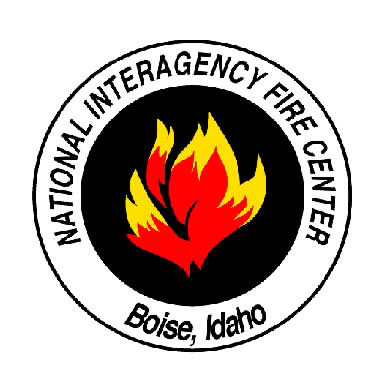
While these factors are positive, we must remember that the forces of gravity will continue to diminish the net effect of a "standard" water or foam/water application (Nozzle Aspirated Foam System or NAFS).
Now, let's shift our attention to the importance of bubbles.
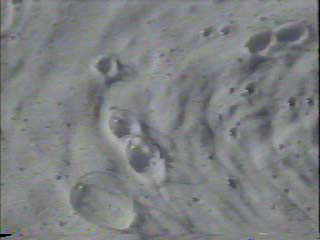
CAFS allows the user to more effectively entrain air into the system, therefore creating a "better bubble." Bubble structure is critical for CAFS to be effective. Better bubbles offer greater durability, greater elasticity, and a greater ability to hold form and position, which allows the bubbles to cling to vertical surfaces where plain water would simply run off.
Since Class A foam is a basic "syndet" detergent or surfactant, let's look how "soap" changes the properties of water to achieve the better bubble.

Have you ever tried to blow a bubble with pure water? It won't work. There is a common misconception that water does not have the necessary surface tension to maintain a bubble and that soap increases it, but in fact soap decreases the pull of surface tension - typically to about a third that of plain water.
The surface tension in plain water is just too strong for bubbles to last for any length of time. One other problem with pure water bubbles is evaporation - the surface quickly becomes thin, causing them to pop. Soap molecules are composed of long chains of carbon and hydrogen atoms. At one end of the chain is a configuration of atoms, which likes to be in water (hydrophilic). The other end shuns water (hydrophobic), but attaches easily to grease. In washing, the greasy end of the soap molecule attaches itself to the grease on your dirty plate, letting water seep in underneath. The particle of grease is pried loose and surrounded by soap molecules and carried off by a flood of water.
In a soap-and-water solution, the hydrophobic (greasy) ends of the soap molecule do not want to be in the liquid at all. Those that find their way to the surface squeeze their way between the surface water molecules, pushing their hydrophobic ends out of the water. This separates the water molecules from each other. Since the surface tension forces become smaller as the distance between water molecules increases, the intervening soap molecules decrease the surface tension.
If that over-filled cup of water mentioned earlier were lightly touched with a slightly soapy finger, the pile of water would immediately spill over the edge of the cup; the surface tension skin is no longer able to support the weight of the water because the soap molecules separated the water molecules, decreasing the attractive force between them.
Because the greasy end of the soap molecule sticks out from the surface of the bubble, the soap film is somewhat protected from evaporation (grease doesn't evaporate), which prolongs the life of the bubble substantially. A closed container saturated with water vapor (as in the Exploratorium "Soap Film" exhibit) also slows evaporation and allows soap films to last even longer.
This is where blown soap bubbles on a watchglass are glued to the bottom of a jar with a large mouth. Once you've sealed the jar the environment will support the bubble for quite a long time. Eiffel Plasterer, a farmer, educator, and bubble fanatic who lived in Huntington, Ind., blew a bubble that lasted for 341 days!
What in the world does this have to do with fire fighting you might ask?
It has everything to do with making water more durable and pliable. This is an essential reason CAFS works. We are able to take water and improve it to where it will stick to surfaces such as walls and ceilings. This where the latent heat of combustion is! If we can truly make water more durable, then it is available for a longer period of time to absorb the caloric output of the fire. It also helps tremendously when it makes the water stay where you put it.
Imagine a straight stream application as being solid or a "single bubble." We have learned in the fire service that we can mechanically alter the straight stream by the addition of a fog or combination nozzle, which breaks up the "single bubble" into many smaller bubbles. By creating many smaller bubbles from the larger bubble we, in effect, have exposed a larger total surface area, which in turn cools the superheated area more effectively.
Now let's imagine that we can safely enter a burning room with that single water/foam bubble held high. The heat of the fire recognizes the cooling effect of the outside diameter of the water/foam bubble. Since fire, or, more correctly, the heat of combustion, only recognizes the surface area of the cooling agent (water bubble) when introduced into a super heated structure - gravity robs the overall effectiveness of the fire stream at its point of most intense heat (ceiling) when applied into that environment. Unfortunately, the effects of gravity pull the foam bubble down from the area of most intense heat before it can effectively use all of the water in the interior of the bubble itself.
Imagine if we could extract the foam solution from the inside of the bubble and create a second, third, fourth, fifth, sixth, and seventh bubble of identical size before the effects of gravity cause it to fall. By doing that, we will have increased the cooling capacity or capability of that single foam bubble by seven times!
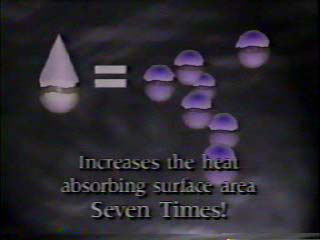
How do we make those durable finished foams? That's where CAFS comes in.
By taking those same seven bubbles and highly compressing each bubble, we have mechanically altered the shape of the bubbles from spherical to more of a "polyhedral" or faceted bubble with many small, flat surfaces.

This allows the bubble to more readily adhere or cling to vertical surfaces and ceilings - or more precisely stated - where the heat is.
It must be understood that the "seven bubble theory" is an approximate number of bubbles created by compounding the single water/foam bubble into seven equal "air/foam" bubbles through the introduction of highly compressed air. It may actually be less in a "wetter" foam and more in a "drier" foam. The relevance of the "seven bubble theory" is important in understanding why we can use such low volume flow ranges of 60 to 70 gpm (water) and achieve such dramatic results.
If you accept the theory of a 7:1 bubble conversion this would mean a CAFS line flowing 70 gpm is giving an approximate finished foam production of nearly 500 gpm (finished foam) at the nozzle.
Supporting articles and documentation show the superior suppression capabilities of CAFS. For those of you who have used a compressed air system on a structure fire, this statement needs no explanation. In study after study, CAFS has proven its performance is superior in reducing knockdown time while at the same time doing it with significantly less water.
Part III
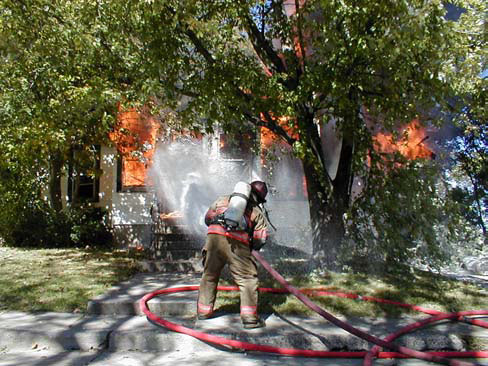
In the last two installments of our study of CAFS, we looked at the history of firefighting and the technological advances that have been introduced to the fire service. Now it's time to start looking at the science of bubbles and fire suppression.
Compressed air foam systems create bubbles by combining water, foam and air. Bubbles make water more durable and able to absorb the caloric output of the fire. In the last two installments, we've looked at water, foam and air and the new technology of firefighting. Now let's look some uses for foam.
But, before we get into the actual application methods and conditional uses of CAFS, let's explore some of the myths and misconceptions I have personally encountered regarding CAFS.
The first question is usually if CAFS is more for a volunteer department. The answer is yes and no. If the inference is that CAFS is well suited for a situation where there might be limited manpower or perhaps limited water supply, this can happen anywhere. Big cities are constantly challenged with call volume versus available staffing. You might have all the water you need, but will you always have the staffing and ability to deliver it when needed? Cities such as Phoenix have been using CAFS with success for nearly a decade.
The second question is, why do we need CAFS when we have all the water we need? Well, do you now? You might feel this that you do indeed have all the water you need, but is that the best answer? Large volumes of water can achieve the desired result, but at what cost? Does more water increase possibility of structural collapse? Does more water necessitate increased delivery demands on staff and machinery?
What created a greater loss for the insured, the fire or our suppression efforts? The use of CAFS has been found to reduce damage of all kinds. This reduced damage and firefighter injury is claimed to save taxpayers substantial money . The Boise (Idaho) Interagency Fire Center found that 75 cents out of each dollar paid out by Oregon insurance companies was spent on water damage and not direct fire damage (Jones, 1990). Water damage to structures is reduced by using CAFS (Liebson, 1990). An analysis of several fires in Idaho and Wyoming, confirmed by insurance adjusters, indicated that operations conducted with CAFS resulted in only 10 to 20 percent of water damage considered normal (Grady, 1994).
In addition, did we increase the potential for the spread of contaminants due to excessive run off? True, we may have all the water we need, but is it the best available option?
Another question focuses on the misconception that CAFS is lighter than water, so it won't go as far, right? That assumption is wrong - the opposite is true. If we sustain the same rate of application, say 70 gpm at 100 PSI, through a straight bore nozzle, the CAFS stream will far outreach the water-only stream. Using much higher volumes and pump pressures will often not project as far as a CAFS stream using half the volume. This is due to the pneumatic action of the foam solution when it is scrubbed in the hose and compresses against the hose wall lining. This compressing action actually maintains a more consistent level of pressure in the entire length of the hoseline. The net result is a delivery system that has very little noticeable friction loss in the hose or in elevated devices. This means we can use longer hose lines and go higher into multiple-layered structures without the need for increasing the pump pressure. This saves manpower and equipment from undue stress.
Another common misconception is that CAFS isn't using enough water to put out the fire. This is, without a doubt, the most often questioned or controversial aspect of using CAFS, especially in structural interior fire fighting. It is important to address this issue in factual terms. There is a recommended minimum flow rate for structural interior attack of 95 gpm. In the real world of structural interior attack we often exceed that amount and more appropriately try to match or exceed the fire load by applying an amount of water determined by some approximate factor such as the IOWA formula.
The reality is that years ago the National Interagency Fire Center (NIFC) in Boise, Idaho, conducted a series of tests to investigate the relative effectiveness of water as a suppression agent on fires. Granted, most of their fires are carbon based, wood, brush, and the like - which is exactly the point of my message. The NIFC concluded that water is approximately 10 percent efficient in the extinguishing of fires. I will not try and create a great debate here, but here are the reasons given for the inefficiency side of that equation. First we know we are going to lose a small percentage of the water exiting the nozzle to stream rainout. Next, we will lose some of the efficiency due to evaporation and that's the part that does the work in the conversion of water into steam at the point of impacting the target. The greatest loss of efficiency is due to runoff - the inability of the water to penetrate (due to surface tension of water) and successfully suppress the fuel. In CAFS we use the Class A foam to overcome this shortfall. But keep in mind, these are "ground fires" and do not factor in gravity.
How much efficiency do you think water retains when we enter an intact, burning structure and direct our firestream at the ceiling where the most intense and dangerous hot gases exist? It is probably safe to assume somewhat less than the 10 percent. The bottom line is we use large volumes of plain water to overcome the inefficiency just described. Not necessarily because we want to, but because we have to in order to achieve knockdown. It seems only logical that we should seek out a better way. For discussion's sake, let's say we are attacking an interior fire with 150 gpm of water. If we factor out the gravity aspect, we may be getting as low as 15 gpm actual benefit out of that firestream.
A CAFS firestream at 75 gpm is operating at a 7:1 compounding factor with nearly total efficiency. In theory (and proven by test after test) the 75 gpm CAFS stream is actually generating approximately 500 gpm of finished foam output, which is staying put on the ceiling. That is where the heat and danger are and that is why in comparative tests a CAFS line is 7 to 10 times more efficient and quicker in obtaining knockdown. Not rocket science, just a little understanding to see how we can do more with less. Remember, bigger isn't always better, right?
The following are measured results of fire suppression utilizing a thermocouple placed four feet off the floor for accurate temperature drop comparison, at the same application rate, under controlled supervision and conditions:
Water as a singular agent takes 222.9 seconds to cool a fire from 1,000 degrees Fahrenheit to 212 degrees Fahrenheit, at the rate of 3.5 degrees per second.
Nozzle Aspirated Foam, on the other hand, takes 102.9 seconds to achieve the same cooling effect at the rate of 7.6 degrees per second.
Compressed Air Foam tops them all at 38.5 seconds at a cooling rate of 20.5 degrees per second.
It's interesting to note that these figures actually give credibility to the "seven bubble theory" or the 7:1 ratio of "bubblettes" created from a single droplet. The results show CAFS achieved nearly a seven times greater heat reduction, using approximately 15 percent of the water, in approximately 1/7th of the time. Time after time, CAFS has proven its superiority in rapid and effective fire suppression.
Next, we need to talk about how and where CAFS is used.
This is really a question that does not have an absolute answer. If we use the guidelines discussed previously as to what constitutes a Class A type fire, then the answer would most likely be all the time unless directed by command to do otherwise.
A Class A fire would simply be defined as a dimensional or carbon-based fuel source. Examples would be wood, paper, hay bales, tires (yes, tires), automobile fires, and "most anything I can hold in my hand that retains form." The exceptions would be some powders and metals that react with water (remember CAFS does contain water).
In addition, CAFS has limiting effects in suppression of vapors, but has been utilized to blanket gases such as ammonia and anhydrous ammonia to limit the potential spread. A plain water fog curtain certainly is effective as CAFS or even more effective, but obviously extends the possibility of increased contaminant spread.
Let's take a look at some specific examples of where CAFS would prove beneficial.
Tire fires present a unique challenge to the fireground. They can generate tremendous amounts of heat and toxic smoke. In addition the rubber compound is impervious to normal water application and simply sheds water as soon as it comes in contact with the tire. This is an ideal situation where CAFS would be initially applied in a heavy-bodied, thick foam to take advantage of the ability to smother the fuel source from the ambient air supply. After initial knockdown the resultant foam blanket will begin to soak in to the tires and aid in suppression and delay rekindle. It may be necessary at this time to go to a more "fluid foam" to aid in seeking out hidden "hot spots."
It's important to remember that CAFS is a tool and not a magic pill.
There will most likely be the need for extensive overhaul and mop up to ensure complete extinguishing. Again, the bottom line is, it can and will be done with less water with proper use of a CAFS/Class A combined attack.
Car fires are certainly an appropriate place to use CAFS. Car fires generate tremendous amounts of heat and smoke. The ability of CAFS to reach and penetrate from greater distances aids in firefighter safety. In addition, CAFS allows the user to blanket the vehicle with foam thus removing stubborn sources of fuel, such as tires, from the fire. Knockdown is achieved with significantly less water.

Let's consider structure fires for a moment. By now you have either bought in to the theory that CAFS can make a difference or you're curious enough to investigate further.
It is proven that CAFS attacks all three sides of the fire triangle simultaneously. The foam blankets the fuel, thereby reducing the fuel's capacity to seek out a source of oxygen. The CAFS solution adheres to ceilings and walls, more readily aiding in rapid reduction in heat. The opaque surfaces of the foam, as it adheres to walls and ceilings, shield the fuel source from radiant energy.
The Class A foam is actually an "attractant" - it has an affinity to mix with hydrocarbons (oleophylic). This is an excellent characteristic as the byproduct of combustion is smoke, which happens to be an unburned hydrocarbon. Thus, the foam actually begins to encapsulate the smoke particles, resulting in a more visible environment.
Gosh. Isn't that a unique way to fight an interior structure fire? CAFS is proven to achieve a more rapid knockdown with a resultant reduction in smoke. That sounds a little safer than what we might be doing presently or have encountered in the past.
By the way, did I mention the handlines are approximately half the weight of a traditional hoseline? See, from our primal introduction to CAFS in the wildfire agency, some brilliant person must have surmised that we are basically fighting the same problems, just on a different scale. Why use CAFS on structures? You tell me why not!

On the wildland interface side of things, the fire service owes a great debt to the forestry or wildland agencies for the introduction of CAFS and Class A foam in fireground operations. What better example than them, with large fire loads, limited manpower, and often limited water supply. That's a true test of the effectiveness of CAFS.
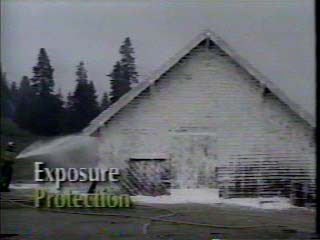
For exposure protection, CAFS is the answer, especially where staffing and/or water may be at premiums. You might not have the resources or the time to set up water curtains. A quick application of a CAFS- generated foam blanket can buy you valuable time and protect property from fire.
Think for a moment what CAFS can do at an attic fire. A traditional attack will usually result in extinguishing the fire, but often "puts the ceiling on the living room floor." CAFS applied in a dry foam isolates the fuel from the source with its blanketing action and uses low volumes of water to achieve this result, thus limiting water-induced damage.
How about a Dumpster fire? Is there anything more trying than a trash fire? Because of the ability to alter the consistency of the foam, troublesome fires, like dumpster and trash bin fires are easily controlled by CAFS without extensive runoff of contents.
Part IV
In the last three installments, we have looked at the elements of a CAFS system, some applications and some of the pro's and cons about the new fire fighting technology. It's now time to look at some of the other, less well known advantages of CAFS. In this, the final installment, we need to recap and summarize the lessons learned.
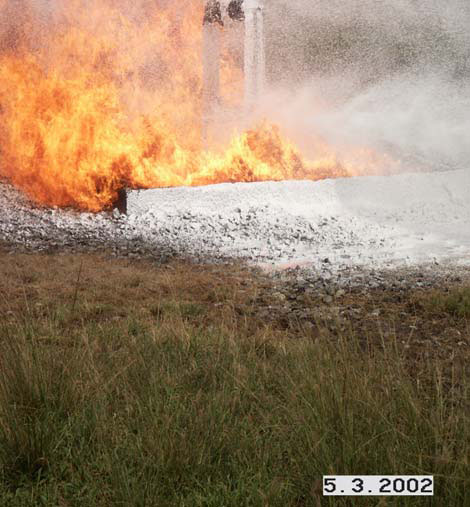
Bioremediation and Nuclear, Biological, and Chemical (NBC) decontamination potential are additional uses for a CAFS firestream. By using specialized foams (Sandia Foam or QAC, Quaternary Ammonium Concentrate) CAFS has been found to be highly effective in achieving desired results with limited runoff and cross-contamination.
In 1999, the Naval Surface Warfare Center, Dahlgren entered into a Cooperative Research Development Agreement with Cummins Industries, Inc. of Joshua, Texas, to assess the compatibility of QAC with CAFS. The QAC/CAFS technology provides the capability for large-area decontamination and can be used before exposure to toxic products in order to prevent contamination. QAC/CAFS can also be adapted to help meet other defense requirements, such as thermal protection from radiation and camouflage from heat-seeking weapons.
Mark Cummins of Cummins Industries shares the following story (Click here to view the full story):
"CAFS technology has similar benefits for environmental restoration of soils and debris contaminated with chemical and biological agents. One recent application of the CAFS system was as a bioremediation system to apply oil-eating microbes to a gasoline pipeline release in Texas. The CAFS 230 Unit was used to apply 4,000 gallons of microbe foam concentrate to remediate 82,000 gallons of gasoline released from the ruptured pipeline."
"The gasoline spill covered 15 acres. Any forest animal within 3 feet of the ground died from the vapors. To address this leakage problem, the entire spill area was covered with approximately 4 inches of hydrocarbon eating microbe foam using a 1000-foot long hose lay."
"The foam blanket sealed the vapors and stopped the problem. Before the CAFS decontamination, the bodies of the dead animals were decaying and emitting a foul odor. Their skin was polluted with the benzene from the fuel. This made the scavengers eat contaminated food. After the CAFS decontamination, there was no odor except the light perfume in the foam. In addition, all the dead animals were washed clean. This was a great improvement. In addition, there was no run-off of the CAFS foam, which is one of the advantages of its utilization."
Cummins said, "The alternative to using the CAFS bioremediation process for this incident was to have the 15 acres of forested land dug up and transported to a licensed landfill that could accept the polluted soil. This would have been cost prohibitive and would only have resulted in moving the contaminated soil from one location to another."
Other commercial uses of CAFS include the cleaning of materials and equipment contaminated with chemical or biological agents; the remediation of contaminated soil/water; response by local/municipal hazardous waste response teams; response by SWAT teams to chemical/biological threats; fighting fires that involve chemical and biological materials; and as a cleaning product for home use.
In addition to the obvious fire suppression uses, CAFS has other benefits including use during water rescues. For example, a CAFS handline can be charged with air to provide a buoyant, stable rescue adjunct. In addition, a larger handline, such as a 2.5-inch line, may be used for dive rescue support. A CAFS handline charged with air will maintain a rigid form more easily than a thinner section of rope and provides a larger surface area for rescuers to grab on to and tie off.
CAFS handline can be used to extend the rescue capabilities of air tools, air bags, and the like. A CAFS line can be filled with air and a cap with proper air tool fitting at the terminal end of the hose. This can give an endless air supply for a protracted rescue effort and reduce the fatigue of carrying air bottles that was previously used for the same chore.
A properly inflated hoseline may be used as an effective spill containment device. This can be rapidly deployed and prevent the spread of additional contaminants until a more appropriate method of containment and remediation is established.
To recap the benefits of CAFS to fire departments, let's look at long list of attributes:
• CAFS improves firefighter safety, improves the efficiency of plain water by five to seven times, it provides a faster means of fire knockdown, offers a rapid reduction in heat, requires less water, and it provides lighter and more manageable hose lines because they are typically half the weight and longer hose lays are possible due to limited friction loss in a CAFS line.
• A compressed air foam system also reduces property damage, offers the ability to change from a wet, to a fluid, to a dry foam by changing the foam percentage, and it lowers pump pressures resulting in fuel savings and the physical drain on staff that would otherwise be fighting with the hose kick from the higher pressures.
• CAFS also attracts unburned hydrocarbons (smoke) making for a cleaner, safer fireground scene, as well as reducing overhaul and mop-up time, and reduces rekindles.
• Other CAFS advantages include protection of exposures, preservation of evidence, faster cleanup because of the soap residue, and it has an extremely limited runoff quality resulting in a more environmentally friendly control of contamination.
• Lastly a CAFS-equipped vehicle can be used in non-suppression efforts for water rescue and dive rescue support, provide a source for compressed air for air bags and air tools, and can be used as an effective containment device for spills.
You might be thinking that if CAFS is so great, why doesn't everyone have it?
The number one deterrent to CAFS is often cost, but that cost can be well justified in safety and firefighter benefits alone. The material cost of a CAFS system is predicated on a lot of variables. How many discharges will utilize CAFS is a big determining factor, as is the size of the compressor.
Another big cost factor is whether the unit needs pump and roll capabilities. Also affecting price are the pump layout and the number of flowmeters and automatic valves required.
As you can see, there are any number of variables. As a rule of thumb you can figure somewhere between $7,000 - $10,000 of additional cost for each CAFS discharge. This may seem high, but keep in mind a Class A foam system typically adds around $15,000 to the price of a vehicle. One of the most expensive parts of the CAF system is the compressor. Weight and size reduction, with no sacrifice of output, comes at a premium that is tacked on to the cost of the compressor.
The second reason for the slow adaptation of CAFS is a "disease" or condition that seems more prevalent in the fire service than in most other industries. It is affectionately referred to as tradition. It's the "we've-been-doin'-it-this-way-for-years" mentality. I am sure you have heard the expression at one time or another "100 years of tradition, unimpeded by progress."
It does not have to be this way. We are doing a better job in reaching out and educating our firefighters. Advances in turnout gear, breathing apparatus, thermal imaging, and on and on, are constantly making the work environment safer. I maintain that with proper training and education, the same holds true for the future of CAFS in fireground operations. We need to give ourselves some credit. If we were to equate our current use of water only for fire suppression, with a parallel to how today's soldier conducts warfare, our infantryman would be riding a horse throwing a stone axe.
In reality our modern-day warrior uses sophisticated weaponry, night vision, laser-guided ordnance. This is "Star Wars" in real life and CAFS is the firefighters' version of a "laser-guided attack."
With all the advantages of CAFS, it's an easy sell. But, you might be wondering what to look for when shopping for a CAFS unit.
The first thing I am going to tell you is true about most any product you buy. Buyer beware. Not all CAFS are created equal. Remember this as the "Golden Rule" prior to purchase. There are many very good CAFS systems and there are marginal units that have flooded the marketplace.
Here is how to distinguish what will serve you best:
First, you should be prepared to do a lot of reading and researching. Each manufacturer spends tons of money on literature regarding their product. This is only a start, but should answer some of the basics. In addition, there are several articles on the Internet that are independent and written by actual users.
Next, always ask for a demonstration at your department. Be specific in detailing your requirements and expectations. If possible use on live fires with a skilled trainer. Insist on a side-by-side comparison of the units if possible. Do not make your decision on a salesman's statements such as "all CAFS units are basically the same." This is like saying all automobiles are the same. If that were true we would all be driving Yugo's.
Look for units that are user-friendly. Look at the pump panel layout. You don't want a unit that adds complexity to operation, significant weight, or requires additional compartment space for equipment or requires significant additional horsepower. These are all negatives and should be avoided at all cost.
It would be a good idea to ask for references. How long has the company you are considering doing business with been producing CAFS units? Where is the nearest unit? Ask for a minimum of 25 departments using their system. If you want to find out who's who in CAFS, ask for 50 or more, and call some of them. You chose whom to call, not the sales rep.
Explore available options with different CAFS manufacturers. Ask if their system can use all four elements at once. In other words, can the CAFS unit produce air only, water only, foam solution only and CAFS out of separate discharge points simultaneously?
You should also find out if the volume of the pump is compromised with the CAFS. And you should always explore any limiting factors of adding CAFS to the apparatus.
If at all possible, you should arrange for a tour of the company's manufacturing facility. This should give you ample insight into the level of quality and commitment dedicated to CAFS production.
It's also a good idea to look for ease of maintenance. This is critical no matter if you are a career department or volunteer department doing your own maintenance. Check to see if the pump, filter and compressor are easily accessed.
Take a close look at the warranty and, more importantly, who stands behind it. The manufacturer should be solely responsible for warranty issues related to the CAFS. You do not want the unpleasant experience of having to deal with the various distributors of the major CAFS components.
Also, check about parts availability. Again, talk with current owners of CAFS units to see if the information you are receiving is accurate.
Remember, CAFS is an expensive add-on to any apparatus. For all the reasons mentioned, you owe it to yourself, your department, and even more so the taxpayers, to research and try a hands-on demonstration.
The net result is you will have progressed into the new millennium of fire suppression.
Should you decide to purchase CAFS you and your department will be truly moving in a forward direction in providing your firefighters with one of the most innovative methods of fire suppression available. There should be no question that CAFS is here and is here to stay.